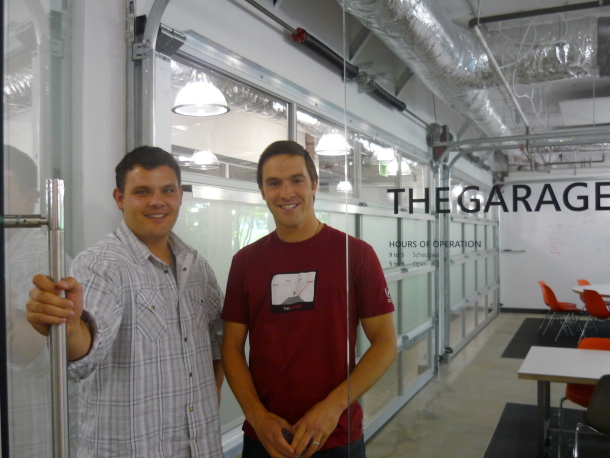Microsoft opens Garage to spark innovation

|
|
(Microsoft's Matt Jubelirer and Quinn Hawkins in the meeting space at the new Microsoft Garage building.) |
Recently, one idea that was invented in The Garage was the “Lync Conversation Translator”. This application is part of Microsoft's enterprise communications. It lets two people who speak different languages have an instant messaging conversation in their native tongue. An English speaker wanting to chat with a German colleague, for example, can type a message in English and have it pop up immediately on their colleague's screen in German. The co-worker can reply in German and the message is dynamically translated into English when it pops up on the original sender's screen a split second later.
You might think that the program, which works with 35 different languages, was the result of a detailed product roadmap concocted by a team of Microsoft employees. Turns out, it was pretty much the brainchild or Harry Emil, a senior test lead in the Lync group, who ginned up the original prototype in his spare time.
Emil worked on the idea during his off-hours at the Garage, a Microsoft initiative to encourage innovation among employees. The two-year-old program helps incubate those side projects that employees want to dive into but can only find time for at night and over weekends.
The Garage gives workers access to tools such as a soldering bench, a laser cutter and a 3D printer. It offers instrumentation for testing prototypes. The Garage will host Web applications. But maybe most important, it connects workers to colleagues with similar interests or needed skills, something that can be challenge at a company with nearly 90,000 employees.
"The goal was to figure out how we could support grassroots innovation," said Garage director Quinn Hawkins.
The Garage, until now, has been more concept than location. But in September 2011, Microsoft opened the doors to the newly remodeled Garage building. The company gutted much of the darkly lit, confusing warren of offices in building 4, where longtime employees could still sometimes get turned around. It's one of the oldest Microsoft buildings in Redmond, Washington, USA.
It took six months to remodel the 60,000 square foot building. Now, the building has huge open gathering spaces and plenty of new windows to let in daylight. Sprinkled around the building are new "pods," temporary work spaces where teams of two, three, or five employees can set up shop to collaborate on projects for weeks at a time.
And just past the reception area is a meeting room that can be opened up to create a larger space by raising two garage doors. "The inspiration came from all the great companies that started in a garage," Hawkins said, legendary tech firms such as Hewlett-Packard and Amazon.
Microsoft remodels building for incubator home (photos)

|

|

|

|
That's important because Microsoft has become a place in recent years where little ideas get lost in the shuffle. For a company that's expected to generate about $70 billion in annual sales as of this writing. That type of financial run rate requires that an idea that might lead to a $10 million a year business, or even $100 million a year one, must not quickly slip through the cracks.
Earlier in 2011, Microsoft shuttered Pioneer Studios, a skunkworks operation to develop consumer electronics and experiences. To some of the company's entrepreneurial employees who'd rather come up with the next breakthrough innovation rather than milk Microsoft's core Windows and Office franchises, the seeming indifference to niche innovations has been a source of frustration.
That's because sometimes, those little breakthroughs turn into massive new businesses. That's why Microsoft launched the Garage. In addition to getting the new space, the Garage also hosts "science fairs", where employees put together poster-board presentations to show off their creations. Judges, wearing white lab coats, select winners, who get to ignite a homemade volcano dubbed Mount St. Awesome as their reward.
Beyond the silliness, the science fairs also offer workers the opportunity to vet their ideas among the hundreds of colleagues who stop by and connect with employees who might offer their expertise. Microsoft held six Garage science fairs in 2010, which featured anywhere from 32 to 49 different projects. Most are held in Redmond, as well as other locations such as Hyderabad, India often. Microsoft has also begun holding "Garage weeks," where business units stop working on Microsoft products. Instead, employees focus on pet projects. Sometimes, their creations have nothing to do with Microsoft's business whatsoever. One employee spent a week working on a self-leveling skateboard, something of a Segway for the skate crowd. Sometimes, they're only peripherally related, such as an immunization tracker application for Windows Phones to help parents keep tabs on the different vaccines their children had received.
"The Garage has taken on a broader context within Microsoft," said Matt Jubelirer, a senior product manager in Office Labs, the business unit for the Garage. "It's created a forum where it feels OK to tinker."
Of course, Microsoft isn't alone in creating that sort of environment. Rival Google has long supported employee innovation with its 20 percent projects, the program there that lets engineers to devote a fifth of their time to tasks of their own choosing.
People like Emil, the creator of the Lync translator, remains grateful for the opportunity to take a chance on his project.
"Basically they said, 'If you succeed, we're going to celebrate that,'" Emil said. "And if you fail, we've got you covered."
Source: news.cnet.com


